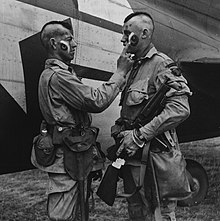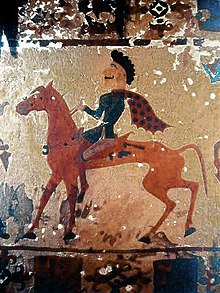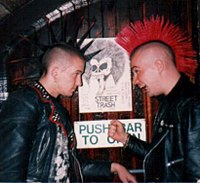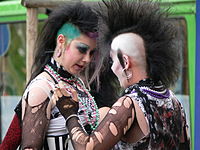Mohawk hairstyle
This article possibly contains original research. (February 2017) |


The mohawk (also referred to as a Mohican) is a hairstyle in which, in the most common variety, both sides of the head are shaven, leaving a strip of noticeably longer hair in the center. It is today worn as an emblem of non-conformity.
The mohawk is also sometimes referred to as an iro in reference to the Iroquois (who include the Mohawk people), from whom the hairstyle is supposedly derived – though historically the hair was plucked out rather than shaved. Additionally, hairstyles bearing these names more closely resemble those worn by the Pawnee, rather than the Mohawk, Mohicans, Mohegan, or other groups whose names are phonetically similar.
The red-haired Clonycavan Man bog body found in Ireland is notable for having a well-preserved Mohawk hairstyle, dated to between 392 BCE and 201 BCE. The world record for the tallest mohawk goes to Kazuhiro Watanabe, who has a 113.5-centimetre (3 ft 8+1⁄2 in) tall mohawk.[1][2]
Name[]

While the mohawk hairstyle takes its name from the people of the Mohawk nation, an indigenous people of North America who originally inhabited the Mohawk Valley in upstate New York,[3] the association comes from Hollywood and more specifically from the popular 1939 film Drums Along the Mohawk starring Henry Fonda.
The Mohawk and the rest of the Iroquois confederacy (Seneca, Cayuga, Onondaga, Tuscarora, and Oneida) in fact wore a square of hair on the back of the crown of the head. The Mohawk did not shave their heads when creating this square of hair but rather pulled the hair out, small tufts at a time. The following is a first-hand account of James Smith, who was captured during the French and Indian war and adopted into the Mohawk tribe:
[A] number of Indians collected about me and one of them began to pull hair out of my head. He had some ashes on a piece of bark in which he frequently dipped his fingers in order to take a firmer hold, and so he went on as if he had been plucking a turkey until he had all the hair clean out of my head, except a small spot about three or four inches square on my crown the remaining hair was cut and three braids formed which were decorated
Therefore, a true hairstyle of the Mohawks was one of plucked-out hair, leaving a three-inch square of hair on the back crown of the head with three short braids of hair decorated. The three braids of a True Mohawk hairstyle are represented today on traditional headdresses of the Mohawk known as a Gustoweh. Mohawk Gustowehs have three upright eagle feathers that represent the three braids of long ago.[4] When not decorated, the very short braids were allowed to hang loose as seen in Good Peter's image in the referenced article.
Historical use[]
The hairstyle has been in existence in many parts of the world for millennia. For instance, the Clonycavan Man, a 2000-year-old male bog body discovered near Dublin in 2003, was found to be wearing a mohawk styled with plant oil and pine resin.[5] Artwork discovered at the Pazyryk burials dating back to 600 BCE depicts Scythian warriors sporting similar mohawks. The body of a warrior occupying one of the kurgans had been scalped earlier in life and wore a hair prosthesis in the form of a mohawk.[6] Herodotus claimed that the Macai, a northern Libyan tribe, "shave their hair so as to leave tufts, letting the middle of their hair grow long, but round this on all sides shaving it close to the skin."[7]
Among the Pawnee people, who historically lived in present-day Nebraska and in northern Kansas, a "mohawk" hairstyle was common.

When going to war, 16th-century Ukrainian Cossacks would shave their heads, leaving a long central strip. This haircut was known as an oseledets or chupryna and was often braided or tied in a topknot.[8]
During World War II, many American GIs, notably paratroopers from the 17th Airborne Division wore mohawks to intimidate their enemies.[9][10] It was also occasionally worn by American troops during the Vietnam War.[11][12] In the early 1950s, mohawks were worn by some jazz musicians like Sonny Rollins.[13][14]

Girl with rattail mohawk, 1951

English punk with spike Mohawk
Varieties[]
Although a mohawk is most widely defined as a narrow, central strip of upright hair running from the forehead to the nape, with the sides of the head bald,[15][16] the term can be applied more loosely to various similar hairstyles, many of which have informal names.
- Rather than the strip of longer hair in the center of the scalp, a reverse mohawk, also known as a nohawk or hawkmo, features a shaved strip from the forehead to the nape of the neck leaving hair on either side of the line. A pioneering example was sported by English rock singer Peter Gabriel whilst on tour with progressive rock band Genesis in 1973.[17]
- A fauxhawk copies the style of a mohawk, but without shaving the sides of the head and not extending past the peak of the cranium. The fauxhawk is typically worn with a small but noticeable spike in the middle, though usually considerably shorter than many traditional mohawks. The style re-emerged in the 2000s, with some of the popularly known wearers being Travis vocalist Fran Healy, David Beckham, Elijah Wood, and Jónsi. The fauxhawk is also known as the "Hoxton fin" after the Hoxton district of London, where it was fashionable in the 1990s.[18]
- A fauxhawk where the hair down the center of the head is longer than the hair on the sides is a euro-hawk. Sometimes the top of the hair is long enough to cover up the shorter sides when combed down. Some of the more popular sports figures and fashion models can be found wearing euro-hawks in various lengths, textures, and colors. The mohawk has been a style mostly seen on punk rockers and the like, but fauxhawks and euro-hawks have transcended to all hair types. The ponyhawk or pony hawk is a type of euro-hawk created by a row of ponytails going down the middle of the head. This look was worn by contestant Sanjaya Malakar on an episode of the television series American Idol.[19]

Two goths with backcombed deathhawks

Wattie Buchan of the Scottish punk rock band The Exploited sporting a dreadhawk

British punk with fauxhawk
See also[]
References[]
- ^ Guinness World Records (November 1, 2012). Guinness World Records 2013. ISBN 9781908843302. Retrieved January 12, 2014.
- ^ "Record Holder Profile - Kazuhiro Watanabe, the world's tallest Mohican hairstyle". guinnessworldrecords.com. September 13, 2012. Retrieved December 2, 2019.
- ^ "Facts for Kids: Mohawk Indians (Mohawks)". www.bigorrin.org.
- ^ Example of Gustowehs.
- ^ "Ireland Bog Bodies". Yahoo! News. Archived from the original on August 18, 2006. Retrieved January 1, 2006.
- ^ S.I. Rudenko, Kul'tura naseleniia Gornogo Altaia v skifskoe vremia ("The Population of the High Altai in Scythian Times")(Moscow and Leningrad, 1953) translated as Frozen Tombs of Siberia: The Pazyryk Burials of Iron Age Horsemen, M.W. Thompson, tr. (University of California Press, Berkeley) 1970. ISBN 0-520-01395-6
- ^ Herodotus. "The History of Herodotus, Book IV, ch. 175". Project Gutenberg.
- ^ Thompson, Ewa Majewska (1991). The Search for self-definition in Russian literature. 27. John Benjamins Publishing Company. pp. 22. ISBN 90-272-2213-4.
- ^ See https://twitter.com/WWIIpix/status/977594040307867650/photo/1 for an example
- ^ "Four Hours of Fury". Scribner. Retrieved April 21, 2020.
- ^ See https://www.flickr.com/photos/redwarriorsvietnam/5427595171/in/photostream for an example
- ^ "Biography for Victor Magnotta". IMDb. Retrieved May 25, 2013.
- ^ "Sonny Rollins wore a Mohawk hairstyle". Audiophile Life. Retrieved May 25, 2013.
- ^ "Lost & Found: Sonny Rollins Interview". Lament For A Straight Line. July 23, 2009. Retrieved May 25, 2013.
- ^ "Definition of Mohawk". education.yahoo.com. Archived from the original on July 18, 2011. Retrieved May 24, 2011.
- ^ "Mohican". Oxford Dictionaries - English.
- ^ "Peter Gabriel Wraps Up the Back to Front Tour". lifeismelody.com.
- ^ "Where have all the cool people gone?". The Guardian. November 21, 2003.
- ^ "Ryan Seacrest Gets Everyone Laughing".
External links[]
- 1980s fashion
- 1990s fashion
- 2000s fashion
- 2010s fashion
- Gothic fashion
- Hairstyles
- Iroquois culture
- Native American culture
- Pawnee
- Punk fashion





